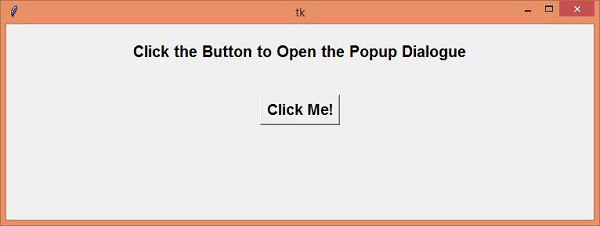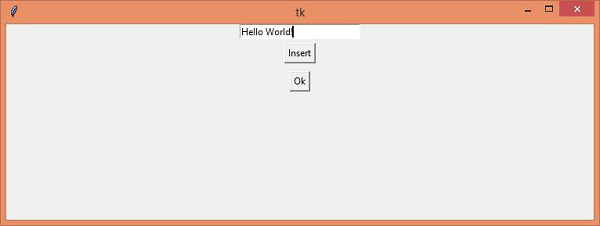在 tkinter 中建立一個包含 Entry 欄位的彈出訊息框
Tkinter 彈出視窗是頂級視窗介面,可以將視窗小部件和元素包裝在主視窗中。可以使用按鈕小部件之類的處理程式將其嵌入到任何主視窗中。可以使用Toplevel(root)建構函式建立彈出視窗。
示例
在這個示例中,我們將建立一個簡單的應用程式,其中包含一個Label 視窗小部件和一個按鈕,用於開啟包含一個Entry 欄位的彈出訊息框。一旦彈出視窗被開啟,它可以具有返回到主視窗的功能。
#Import the required library
from tkinter import*
#Create an instance of tkinter frame
win= Tk()
#Define geometry of the window
win.geometry("750x250")
#Define a function to close the popup window
def close_win(top):
top.destroy()
def insert_val(e):
e.insert(0, "Hello World!")
#Define a function to open the Popup Dialogue
def popupwin():
#Create a Toplevel window
top= Toplevel(win)
top.geometry("750x250")
#Create an Entry Widget in the Toplevel window
entry= Entry(top, width= 25)
entry.pack()
#Create a Button to print something in the Entry widget
Button(top,text= "Insert", command= lambda:insert_val(entry)).pack(pady= 5,side=TOP)
#Create a Button Widget in the Toplevel Window
button= Button(top, text="Ok", command=lambda:close_win(top))
button.pack(pady=5, side= TOP)
#Create a Label
label= Label(win, text="Click the Button to Open the Popup Dialogue", font= ('Helvetica 15 bold'))
label.pack(pady=20)
#Create a Button
button= Button(win, text= "Click Me!", command= popupwin, font= ('Helvetica 14 bold'))
button.pack(pady=20)
win.mainloop()輸出
執行上述程式碼將顯示一個視窗,其中包含一個按鈕,用於開啟彈出對話方塊。

一旦我們點選按鈕,它將開啟彈出對話方塊。彈出對話方塊有兩個按鈕,每個按鈕具有不同的目的。當我們點選“確定”按鈕時,它將銷燬彈出視窗並返回主視窗。


廣告

 資料結構
資料結構 網路
網路 RDBMS
RDBMS 作業系統
作業系統 Java
Java iOS
iOS HTML
HTML CSS
CSS Android
Android Python
Python C 程式設計
C 程式設計 C++
C++ C#
C# MongoDB
MongoDB MySQL
MySQL Javascript
Javascript PHP
PHP